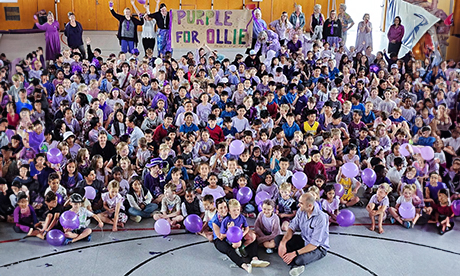A pupil with a disease likened to childhood dementia is much loved at the “fantastic and welcoming” St Mary’s Catholic School in Rotorua , his mum says.
The school as a whole is supporting Ollie Schimanski whose rare genetic metabolism disorder (Sanfilippo Syndrome) causes fatal brain damage, Ollie’s mother Charlotte Schimanski explains.
There is no treatment or cure for Sanfilippo. The average life expectancy of sufferers is between 12 and 20 years.
Supportive school
In a media interview to raise awareness about Ollie’s illness, Schimanski took time to praise the way St Mary’s Catholic School is caring for her son.
He goes to school every day. He has “an absolute ball” she said.
In fact the whole school is “super-supportive” and held a fundraiser on November 16 for World Sanfilippo Awareness Day.
Students wore purple to school and donated a gold coin which will go to the Sanfilippo Children’s Foundation, she said.
Speaking for the school, St Mary’s Catholic Primary School deputy principal Brigitte Holmes says Ollie is “adored” by students.
Ollie appreciated the school community supporting the “Wear Purple for Ollie Day” she says.
“We want Ollie to continue enjoying school, we want Emma [his older sister] to have this time at school with her little brother and we want Ollie’s family to know that we love having Ollie at St Mary’s.”
At home, Ollie is active. He likes mountain biking, skateboarding and going on tractors and motorbikes at a farm.
Even though he doesn’t have the cognitive ability to be able to do some of those things, “he definitely gives it a go” his mother says.
Sanfilippo
Schimanski wants to raise awareness about Ollie’s rare condition in the hope that more research will be dedicated to Sanfilippo.
“We wouldn’t want any other kid to have to go through what he is going through and how much worse it will get” she says.
She explains people with Sanfilippo are missing the enzyme that “breaks down cellular waste”.
“Instead of it getting out of the body, it deposits … mainly in the brain so that’s why it causes that dementia illness.”
She says there are two major clinical trials overseas.
One involves gene therapy.
That treatment would “turn on the gene that he [Ollie] needs” and help promote the missing enzyme’s production. However, it could not reverse the damage already done, Schimanski says.
Most studies however show it’s most effective if the child gets gene therapy before the age of two, she says.
Another clinical trial Schimanski mentions involves “enzyme replacement therapy”. This requires an injection into the brain every two weeks. There are no guarantees it would work though.
Help, support, research
The Australian-based Sanfilippo Children’s Foundation provides information and connects families with specialists.
While there’s nothing people can really do to help, research offers hope Schmanski says.
“I think the key thing is research because there’s no cure, there’s no treatment. All we can ask for is research so that other kids don’t have to go through it.”
Source
